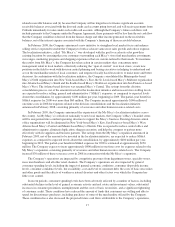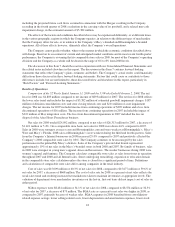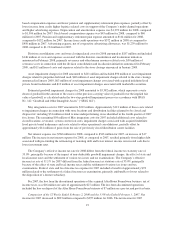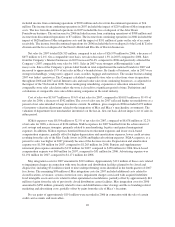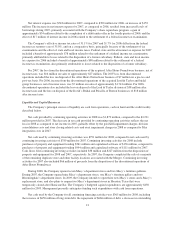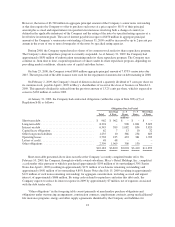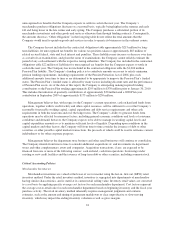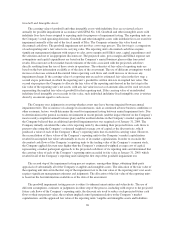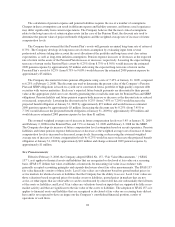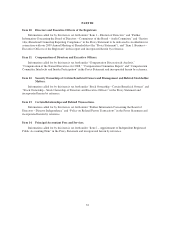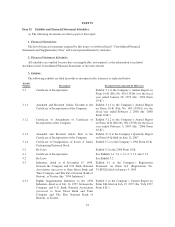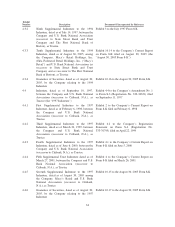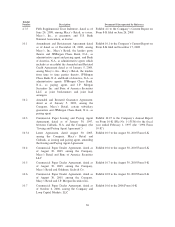Macy's 2008 Annual Report Download - page 33
Download and view the complete annual report
Please find page 33 of the 2008 Macy's annual report below. You can navigate through the pages in the report by either clicking on the pages listed below, or by using the keyword search tool below to find specific information within the annual report.could materially increase or decrease the fair value of the reporting unit’s net assets and, accordingly, could
materially increase or decrease any related impairment charge. The first step of the impairment testing process
considers company-specific projections, the discount rate and the Company’s market capitalization around the
testing period. The second step of the impairment testing process considers third party estimates of the fair value
of certain assets and liabilities. The Company recorded an estimated goodwill impairment charge of $5,382
million during 2008. Increasing or decreasing the fair values of the net assets of each reporting unit by 5% as
compared to the values used in the preparation of these financial statements would increase or decrease the
impairment charge related to goodwill by approximately $153 million.
Self-Insurance Reserves
The Company, through its insurance subsidiaries, is self-insured for workers’ compensation and public
liability claims up to certain maximum liability amounts. Although the amounts accrued are actuarially
determined by third parties based on analysis of historical trends of losses, settlements, litigation costs and other
factors, the amounts the Company will ultimately disburse could differ from such accrued amounts.
Pension and Supplementary Retirement Plans
The Company has a funded defined benefit pension plan (the “Pension Plan”) and an unfunded defined
benefit supplementary retirement plan (the “SERP”). The Company accounts for these plans using SFAS No. 87,
“Employers’ Accounting for Pensions” (“SFAS 87”), as amended by SFAS No. 158, “Employers’ Accounting
for Defined Benefit Pension and Other Postretirement Plans – an amendment of FASB Statements No. 87, 88,
106, and 132(R)” (“SFAS 158”). Under SFAS 158, an employer recognizes the funded status of a defined benefit
postretirement plan as an asset or liability on the balance sheet and recognizes changes in that funded status in
the year in which the changes occur through comprehensive income. Under SFAS 87, pension expense is
recognized on an accrual basis over employees’ approximate service periods. Pension expense calculated under
SFAS 87 is generally independent of funding decisions or requirements.
Effective February 4, 2007, the Company adopted the measurement date provision of SFAS 158, which
requires the measurement of defined benefit plan assets and obligations to be the date of the Company’s fiscal
year-end balance sheet. This required a change in the Company’s measurement date, which was previously
December 31.
During 2006, Congress passed the Pension Protection Act of 2006 (the “Act”) with the stated purpose of
improving the funding of America’s private pension plans. The Act introduced new funding requirements for
defined benefit pension plans, introduces benefit limitations for certain under-funded plans and raises tax
deduction limits for contributions. The Act applies to pension plan years beginning after December 31, 2007.
Funding requirements for the Pension Plan are determined by government regulations, not SFAS 87 or SFAS
158. No funding contributions were required, and the Company made no funding contributions to the Pension
Plan in 2008 or 2007. As of the date of this report, the Company is anticipating making required funding
contributions to the Pension Plan totaling approximately $295 million to $370 million prior to January 30, 2010.
This includes the initiation of quarterly payments of approximately $30 million and a 2008 Plan year contribution
in September 2009 of approximately $175 million to $250 million. Management believes that, with respect to the
Company’s current operations, cash on hand and funds from operations, together with its credit facility and other
capital resources, will be sufficient to cover the Company’s Pension cash requirements in both the near term and
over the longer term.
At January 31, 2009, the Company had an unrecognized actuarial loss of $875 million for the Pension Plan
and an unrecognized actuarial gain of $19 million for the SERP. The unrecognized loss for the Pension Plan and
the unrecognized gain for the SERP will be recognized as a component of pension expense in future years in
accordance with SFAS No. 87, but are not expected to impact 2009 Pension and SERP expense.
27


